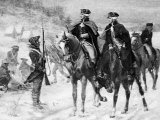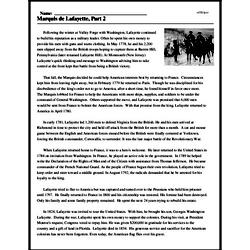Marquis de Lafayette, Part 2
Marquis de Lafayette
Reading Comprehension for September 6
Following the winter at Valley Forge with Washington, Lafayette continued to build his reputation as a military leader. Often he spent his own money to provide his men with guns and warm clothing. In May 1778, he and his 2,200 men slipped away from the British troops hoping to capture them at Barren Hill, Pennsylvania (later renamed Lafayette Hill). At Monmouth (New Jersey) Lafayette's quick thinking and message to Washington advising him to take control at the front kept that battle from being a British victory.
That fall, the Marquis decided he could help American interests best by returning to France. Circumstances kept him from leaving right away, but in February 1779 he returned to Paris. Though he was disciplined for his disobedience of the king's order not to go to America, after a short time, he found himself in favor once more. The Marquis lobbied for France to help the Americans with more ships, supplies, and soldiers to be under the command of General Washington. Others supported the move, and Lafayette was promised that 6,000 men would be sent from France to bolster the American forces. With that promise from the king, Lafayette returned to America in April 1780.
In early 1781, Lafayette led 1,200 men to defend Virginia from the British. He and his men arrived at Richmond in time to protect the city and held off attack from the British for more than a month. A cat and mouse game between the English and American forces ensued before the British were finally cornered at Yorktown, forcing the British commander, Cornwallis, to surrender. It was the last major battle of the Revolutionary War.



